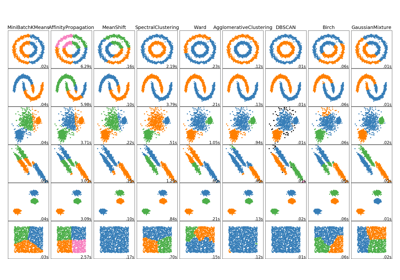sklearn.cluster.AffinityPropagation¶
-
class
sklearn.cluster.AffinityPropagation(damping=0.5, max_iter=200, convergence_iter=15, copy=True, preference=None, affinity='euclidean', verbose=False)[source]¶ Perform Affinity Propagation Clustering of data.
Read more in the User Guide.
Parameters: - damping : float, optional, default: 0.5
Damping factor (between 0.5 and 1) is the extent to which the current value is maintained relative to incoming values (weighted 1 - damping). This in order to avoid numerical oscillations when updating these values (messages).
- max_iter : int, optional, default: 200
Maximum number of iterations.
- convergence_iter : int, optional, default: 15
Number of iterations with no change in the number of estimated clusters that stops the convergence.
- copy : boolean, optional, default: True
Make a copy of input data.
- preference : array-like, shape (n_samples,) or float, optional
Preferences for each point - points with larger values of preferences are more likely to be chosen as exemplars. The number of exemplars, ie of clusters, is influenced by the input preferences value. If the preferences are not passed as arguments, they will be set to the median of the input similarities.
- affinity : string, optional, default=``euclidean``
Which affinity to use. At the moment
precomputedandeuclideanare supported.euclideanuses the negative squared euclidean distance between points.- verbose : boolean, optional, default: False
Whether to be verbose.
Attributes: - cluster_centers_indices_ : array, shape (n_clusters,)
Indices of cluster centers
- cluster_centers_ : array, shape (n_clusters, n_features)
Cluster centers (if affinity !=
precomputed).- labels_ : array, shape (n_samples,)
Labels of each point
- affinity_matrix_ : array, shape (n_samples, n_samples)
Stores the affinity matrix used in
fit.- n_iter_ : int
Number of iterations taken to converge.
Notes
For an example, see examples/cluster/plot_affinity_propagation.py.
The algorithmic complexity of affinity propagation is quadratic in the number of points.
When
fitdoes not converge,cluster_centers_becomes an empty array and all training samples will be labelled as-1. In addition,predictwill then label every sample as-1.When all training samples have equal similarities and equal preferences, the assignment of cluster centers and labels depends on the preference. If the preference is smaller than the similarities,
fitwill result in a single cluster center and label0for every sample. Otherwise, every training sample becomes its own cluster center and is assigned a unique label.References
Brendan J. Frey and Delbert Dueck, “Clustering by Passing Messages Between Data Points”, Science Feb. 2007
Examples
>>> from sklearn.cluster import AffinityPropagation >>> import numpy as np >>> X = np.array([[1, 2], [1, 4], [1, 0], ... [4, 2], [4, 4], [4, 0]]) >>> clustering = AffinityPropagation().fit(X) >>> clustering # doctest: +NORMALIZE_WHITESPACE AffinityPropagation(affinity='euclidean', convergence_iter=15, copy=True, damping=0.5, max_iter=200, preference=None, verbose=False) >>> clustering.labels_ array([0, 0, 0, 1, 1, 1]) >>> clustering.predict([[0, 0], [4, 4]]) array([0, 1]) >>> clustering.cluster_centers_ array([[1, 2], [4, 2]])
Methods
fit(X[, y])Create affinity matrix from negative euclidean distances, then apply affinity propagation clustering. fit_predict(X[, y])Performs clustering on X and returns cluster labels. get_params([deep])Get parameters for this estimator. predict(X)Predict the closest cluster each sample in X belongs to. set_params(**params)Set the parameters of this estimator. -
__init__(damping=0.5, max_iter=200, convergence_iter=15, copy=True, preference=None, affinity='euclidean', verbose=False)[source]¶ Initialize self. See help(type(self)) for accurate signature.
-
fit(X, y=None)[source]¶ Create affinity matrix from negative euclidean distances, then apply affinity propagation clustering.
Parameters: - X : array-like, shape (n_samples, n_features) or (n_samples, n_samples)
Data matrix or, if affinity is
precomputed, matrix of similarities / affinities.- y : Ignored
-
fit_predict(X, y=None)[source]¶ Performs clustering on X and returns cluster labels.
Parameters: - X : ndarray, shape (n_samples, n_features)
Input data.
- y : Ignored
not used, present for API consistency by convention.
Returns: - labels : ndarray, shape (n_samples,)
cluster labels
-
get_params(deep=True)[source]¶ Get parameters for this estimator.
Parameters: - deep : boolean, optional
If True, will return the parameters for this estimator and contained subobjects that are estimators.
Returns: - params : mapping of string to any
Parameter names mapped to their values.
-
predict(X)[source]¶ Predict the closest cluster each sample in X belongs to.
Parameters: - X : {array-like, sparse matrix}, shape (n_samples, n_features)
New data to predict.
Returns: - labels : array, shape (n_samples,)
Index of the cluster each sample belongs to.
-
set_params(**params)[source]¶ Set the parameters of this estimator.
The method works on simple estimators as well as on nested objects (such as pipelines). The latter have parameters of the form
<component>__<parameter>so that it’s possible to update each component of a nested object.Returns: - self



